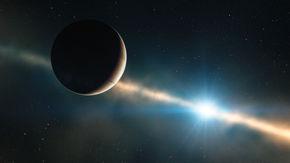Astronomers hope to glimpse giant newborn planet’s rings and moons during rare transit

Astronomers are staring at a nearby star in hopes of seeing a giant baby of a planet pass across its face, perhaps accompanied by dust clouds, rings, or newborn moons. Last week, the newest and tiniest telescope joined the vigil, when the French-built PicSat rode into orbit on an Indian rocket. It will be able to continuously monitor the star, β Pictoris, until chances of seeing the once-in-20-year transit event diminish in a few months’ time. “We can’t miss this. We would be kicking ourselves,” says astronomer Matthew Kenworthy of Leiden University in the Netherlands.
Astronomers have seen thousands of exoplanets transit, or cross the face of their stars, eclipsing a fraction of their light. But β Pictoris, a bright star just 63 light-years away, is special. It is a natural laboratory for how solar systems form because it is only 24 million years old—the “equivalent of a baby of a few weeks,” says Sylvestre Lacour of the Paris Observatory.
